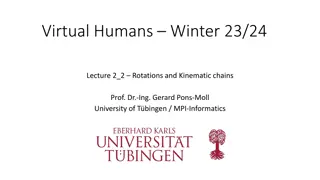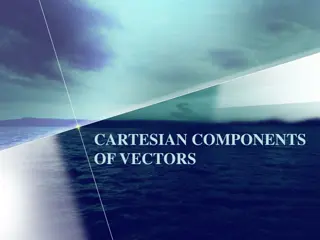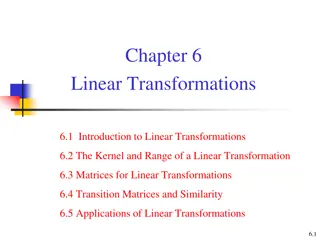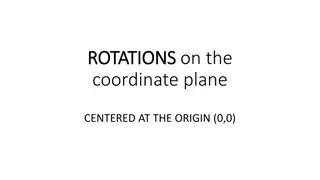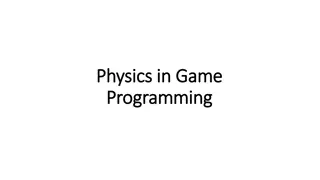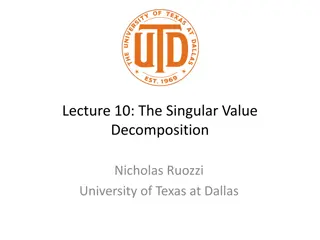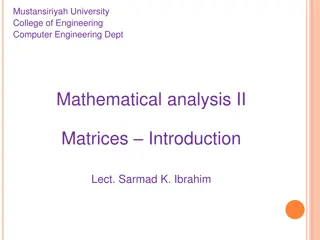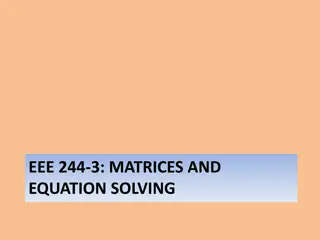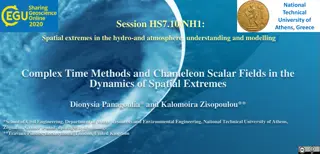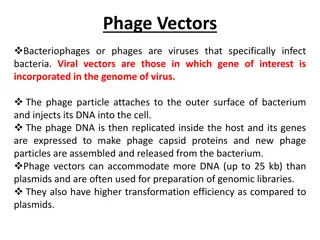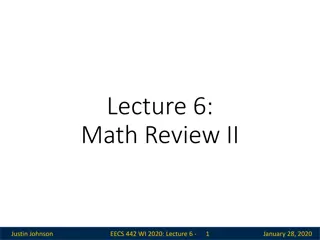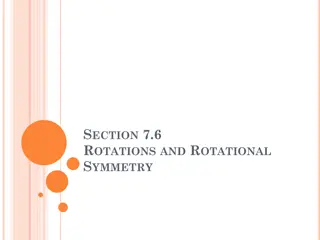Vectors, Matrices, and Rotations in Euclidean Space
Explore the fundamentals of vectors, matrices, rotations, and coordinate transformations in Euclidean space. Learn about points, tensors, and the significance of vectors in representing physical quantities. Discover the Parallelogram Law and Coordinate Frames for effective visualization and computation.
Download Presentation

Please find below an Image/Link to download the presentation.
The content on the website is provided AS IS for your information and personal use only. It may not be sold, licensed, or shared on other websites without obtaining consent from the author.If you encounter any issues during the download, it is possible that the publisher has removed the file from their server.
You are allowed to download the files provided on this website for personal or commercial use, subject to the condition that they are used lawfully. All files are the property of their respective owners.
The content on the website is provided AS IS for your information and personal use only. It may not be sold, licensed, or shared on other websites without obtaining consent from the author.
E N D
Presentation Transcript
1 Vectors, Matrices, Rotations, Axis Transformations Texture, Microstructure & Anisotropy A.D. Rollett Most of the material in these slides originated in lecture notes by Prof. Brent Adams (now emeritus at BYU). Last revised: 9 Nov. 11
2 Notation X x1,x2,x3 coordinates of a point u vector o origin base vector (3 dirn.) 1 coefficient of a vector Kronecker delta eijk permutation tensor aij, ij rotation matrix (passive) or, axis transformation gij rotation matrix (active*) point u (ui) vector (row or column) ||u|| L2 norm of a vector A (Aij) general second rank tensor (matrix) eigenvalue v eigenvector I Identity matrix AT transpose of matrix n, r rotation axis rotation angle tr trace (of a matrix) 3 3D Euclidean space * in most texture books, g denotes an axis transformation, or passive rotation!
3 Points, vectors, tensors, dyadics Material points of the crystalline sample, of which x and y are examples, occupy a subset of the three-dimensional Euclidean point space, 3, which consists of the set of all ordered triplets of real numbers, {x1,x2,x3}. The term point is reserved for elements of 3. The numbers x1,x2,x3describe the location of the point x by its Cartesian coordinates. Cartesian; from Ren Descartes, a French mathematician, 1596 to 1650.
4 VECTORS The difference between any two points defines a vector according to the relation directed line segment with its origin at x and its terminus at y. Since it possesses both a direction and a length the vector is an appropriate representation for physical quantities such as force, momentum, displacement, etc. . As such denotes the
5 Parallelogram Law Two vectors u and v compound (addition) according to the parallelogram law. If u and v are taken to be the adjacent sides of a parallelogram (i.e., emanating from a common origin), then a new vector, w, is defined by the diagonal of the parallelogram which emanates from the same origin. The usefulness of the parallelogram law lies in the fact that many physical quantities compound in this way.
6 Coordinate Frame It is convenient to introduce a rectangular Cartesian coordinate frame for consisting of the base vectors , , and and a point o called the origin. These base vectors have unit length, they emanate from the common origin o, and they are orthogonal to each another. By virtue of the parallelogram law any vector can be expressed as a vector sum of these three base vectors according to the expressions
7 Coordinate Frame, contd. where the components of in the specified coordinate system. In the previous equation, the standard shorthand notation has been introduced. This is known as the summation convention. Repeated indices in the same term indicate that summation over the repeated index, from 1 to 3, is required. This notation will be used throughout the text whenever the meaning is clear. are real numbers called
8 Magnitude of a vector The magnitude,v, of is related to its components through the parallelogram law: You will also encounter this quantity as the L2 Norm in matrix-vector algebra:
9 Scalar Product (Dot product) The scalar product u vof the two vectors and whose directions are separated by the angle is the scalar quantity where u and v are the magnitudes of u and v respectively. Thus, u v is the product of the projected length of one of the two vectors with the length of the other. Evidently the scalar product is commutative, since:
10 Cartesian coordinates There are many instances where the scalar product has significance in physical theory. Note that if and are perpendicular then =0, if they are parallel then =uv , and if they are antiparallel =-uv. Also, the Cartesian coordinates of a pointx, with respect to the chosen base vectors and coordinate origin, are defined by the scalar product
11 For the base vectors themselves the following relationships exist The symbol is called the Kronecker delta. Notice that the components of the Kronecker delta can be arranged into a 3x3 matrix, I, where the first index denotes the row and the second index denotes the column. I is called the unit matrix; it has value 1 along the diagonal and zero in the off-diagonal terms.
12 Vector Product (Cross Product) The vector product is the vector normal to the plane containing and , and oriented in the sense of a right-handed screw rotating from to . The magnitude of is given by uv sin , which corresponds to the area of the parallelogram bounded by and . A convenient expression for in terms of components employs the alternating symbol, e or of vectors and
13 Permutation tensor, eijk Related to the vector and scalar products is the triple scalar product which expresses the volume of the parallelipiped bounded on three sides by the vectors , and . In component form it is given by
14 Handed-ness of Base Vectors With regard to the set of orthonormal base vectors, these are usually selected in such a manner that . Such a coordinate basis is termed right handed. If on the other hand then the basis is left handed. ,
15 CHANGES OF THE COORDINATE SYSTEM Many different choices are possible for the orthonormal base vectors and origin of the Cartesian coordinate system. A vector is an example of an entity which is independent of the choice of coordinate system. Its direction and magnitude must not change (and are, in fact, invariants), although its components will change with this choice.
16 New Axes Consider a new orthonormal system consisting of right-handed base vectors with the same origin, o, associated with and ^ ^ e3 e 3 ^ The vector e 2 ^ e2 is clearly expressed equally well in either coordinate system: ^ ^ e1 e 1 Note - same vector, different values of the components. We need to find a relationship between the two sets of components for the vector.
17 Direction Cosines The two systems are related by the nine direction cosines, , which fix the cosine of the angle between the ithprimed and the jth unprimed base vectors: Equivalently, represent the components of in according to the expression
18 Direction Cosines, contd. That the set of direction cosines are not independent is evident from the following construction: Thus, there are six relationships (itakes values from 1 to 3, and j takes values from 1 to 3) between the nine direction cosines, and therefore only three are independent.
19 Orthogonal Matrices Note that the direction cosines can be arranged into a 3x3 matrix, , and therefore the relation above is equivalent to the expression where T denotes the transpose of . This relationship identifies as an orthogonal matrix, which has the properties
20 Relationships When both coordinate systems are right-handed, det( )=+1 and is a proper orthogonal matrix. The orthogonality of also insures that, in addition to the relation above, the following holds: Combining these relations leads to the following inter- relationships between components of vectors in the two coordinate systems:
21 Transformation Law These relations are called the laws of transformation for the components of vectors. They are a consequence of, and equivalent to, the parallelogram law for addition of vectors. That such is the case is evident when one considers the scalar product expressed in two coordinate systems:
22 Invariants Thus, the transformation law as expressed preserves the lengths and the angles between vectors. Any function of the components of vectors which remains unchanged upon changing the coordinate system is called an invariant of the vectors from which the components are obtained. The derivations illustrate the fact that the scalar product, is an invariant of the vectors u and v. Other examples of invariants include the vector product of two vectors and the triple scalar product of three vectors. Note that the transformation law for vectors also applies to the components of points when they are referred to a common origin.
23 Rotation Matrices Since an orthogonal matrix merely rotates a vector but does not change its length, the determinant is one, det( )=1.
24 Orthogonality A rotation matrix, , is an orthogonal matrix, however, because each row is mutually orthogonal to the other two. Equally, each column is orthogonal to the other two, which is apparent from the fact that each row/column contains the direction cosines of the new/old axes in terms of the old/new axes and we are working with [mutually perpendicular] Cartesian axes.
25 Vector realization of rotation The convenient way to think about a rotation is to draw a plane that is normal to the rotation axis. Then project the vector to be rotated onto this plane, and onto the rotation axis itself. Then one computes the vector product of the rotation axis and the vector to construct a set of 3 orthogonal vectors that can be used to construct the new, rotated vector.
26 Vector realization of rotation One of the vectors does not change during the rotation. The other two can be used to construct the new vector. Note that this equation does not require any specific coordinate system; we will see similar equations for the action of matrices, Rodrigues vectors and (unit) quaternions
27 Rotations (Active): Axis- Angle Pair A rotation is commonly written as ( , ) or as (n, ). The figure illustrates the effect of a rotation about an arbitrary axis, OQ (equivalent to and n) through an angle (equivalent to and ). (This is an active rotation: a passive rotation axis transformation)
28 Axis Transformation from Axis-Angle Pair The rotation can be converted to a matrix (passive rotation) by the following expression, where is the Kronecker delta and is the permutation tensor; note the change of sign on the off-diagonal terms. Compare with active rotation matrix!
29 Rotation Matrix for Axis Transformation from Axis-Angle Pair This form of the rotation matrix is a passive rotation, appropriate to axis transformations
30 Eigenvector of a Rotation A rotation has a single (real) eigenvector which is the rotation axis. Since an eigenvector must remain unchanged by the action of the transformation, only the rotation axis is unmoved and must therefore be the eigenvector, which we will callv. Note that this is a different situation from other second rank tensors which may have more than one real eigenvector, e.g. a strain tensor.
31 Characteristic Equation An eigenvector corresponds to a solution of the characteristic equation of the matrix a, where is a scalar: av = v (a - I)v = 0 det(a - I) = 0
32 Rotation: physical meaning Characteristic equation is a cubic and so three eigenvalues exist, for each of which there is a corresponding eigenvector. Consider however, the physical meaning of a rotation and its inverse. An inverse rotation carries vectors back to where they started out and so the only feature to distinguish it from the forward rotation is the change in sign. The inverse rotation, a-1 must therefore share the same eigenvector since the rotation axis is the same (but the angle is opposite).
33 Forward vs. Reverse Rotation Therefore we can write: av = a-1v = v, and subtract the first two quantities. (a a-1) v = 0. The resultant matrix, (a a-1) clearly has zero determinant (required for non-trivial solution of a set of homogeneous equations).
34 Eigenvalue = +1 To prove that (a - I)v = 0 ( = 1): Multiply by aT: aT(a - I)v = 0 Add the first and last equations: If aTa I, then the last step would not be valid. The last result was already demonstrated. (aTa - aT)v = 0 (I- aT)v = 0. Orthogonal matrix property (a - I)v + (I- aT)v = 0 (a - aT)v = 0.
35 Rotation Axis from Matrix One can extract the rotation axis,n, (the only real eigenvector, same asvin previous slides, associated with the eigenvalue whose value is +1) in terms of the matrix coefficients for (a - aT)v = 0, with a suitable normalization to obtain a unit vector: Note the order (very important) of the coefficients in each subtraction; again, if the matrix represents an active rotation, then the sign is inverted.
Rotation Axis from Matrix, contd. 36 (a a-1) = Given this form of the difference matrix, based ona-1 = aT, the only non-zero vector that will satisfy(a a-1) n = 0is:
37 Rotation Angle from Matrix Another useful relation gives us the magnitude of the rotation, , in terms of the trace of the matrix,aii: , therefore, cos = 0.5 (trace(a) 1). - In numerical calculations, it can happen that tr(a)-1 is either slightly greater than 1 or slightly less than -1. Provided that there is no logical error, it is reasonable to truncate the value to +1 or -1 and then apply ACOS. - Note that if you try to construct a rotation of greater than 180 (which is perfectly possible using the formulas given), what will happen when you extract the axis-angle is that the angle will still be in the range 0-180 but you will recover the negative of the axis that you started with. This is a limitation of the rotation matrix (which the quaternion does not share).
38(Small) Rotation Angle from Matrix What this shows is that for small angles, it is safer to use a sine-based formula to extract the angle (be careful to include only a12-a21, but not a21-a12). However, this is strictly limited to angles less than 90 because the range of ASIN is - /2 to + /2, in contrast to ACOS, which is 0 to , and the formula below uses the squares of the coefficients, which means that we lose the sign of the (sine of the) angle. Thus, if you try to use it generally, it can easily happen that the angle returned by ASIN is, in fact, - because the positive and the negative versions of the axis will return the same value.
39 Rotation Angle = 180 A special case is when the rotation, , is equal to 180 (= ). The matrix then takes the special form: In this special case, the axis is obtained thus: However, numerically, the standard procedure is surprisingly robust and, apparently, only fails when the angle is exactly 180 .
40Trace of the (mis)orientation matrix Thus the cosine, v, of the rotation angle, v=cos , expressed in terms of the Euler angles:
41 Is a Rotation a Tensor? (yes!) Recall the definition of a tensor as a quantity that transforms according to this convention, where is an axis transformation, anda is a rotation: a = Ta Since this is a perfectly valid method of transforming a rotation from one set of axes to another, it follows that an active rotation can be regarded as a tensor. (Think of transforming the axes on which the rotation axis is described.)
42 Matrix, Miller Indices In the following, we recapitulate some results obtained in the discussion of texture components (where now it should be clearer what their mathematical basis actually is). The general Rotation Matrix, a, can be represented as in the following: [100] direction [010] direction [001] direction Where the Rows are the direction cosines for [100], [010], and [001] in the sample coordinate system (pole figure).
43 Matrix, Miller Indices The columns represent components of three other unit vectors: ND (hkl) [uvw] RD TD Where the Columns are the direction cosines (i.e. hkl or uvw) for the RD, TD and Normal directions in the crystal coordinate system.
44 Compare Matrices [uvw] (hkl) [uvw] (hkl)
45 Summary The rules for working with vectors and matrices, i.e. mathematics, especially with respect to rotations and transformations of axes, has been reviewed.
46 Supplemental Slides [none]



